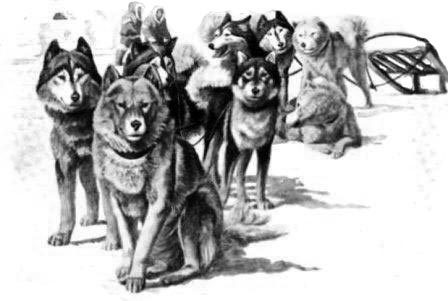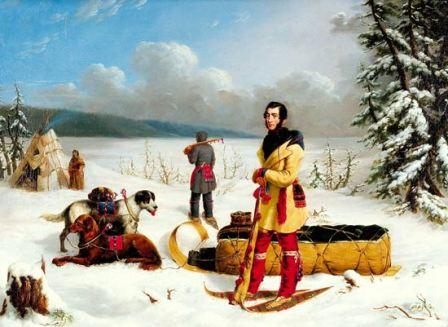Arctic Indians - Lifestyle (Way of Living)
The climate, land and natural resources that were available to the Indian tribes resulted in the adoption of the Arctic Indians culture.
- Name of Group: Arctic Indians
- Languages: Eskimo-Aleut languages and Athabascan
- Geography of the State of Arctic Indians: Present day Alaska, Canada and Greenland. An inhospitable landscape consisting of a flat, cold and treeless, tundra region
- Animals: Seal, caribou, otter, polar bears, whale, walrus and Arctic birds
- Natural Resources: Fish, seasonal berries and plants
- Culture and Lifestyle adopted: Nomadic Hunters and fishermen
- Transport: Dogsleds (qamutik), Leather-covered, watertight canoes and open fishing boats such as Inuit Kayaks and Aleut Baidarkas.
- Clothes: Clothing was made from caribou or other deer hides and they wore snowshoes
- Types of housing, homes or shelters: Igloos, Sod Houses, Igloos, Barabaras and tepee style tents
- Famous Tribes of Arctic Indians: The Alaska Aleut and the Inuit (aka Eskimo) and Tlingit
- The Native Indians who lived on the borders of lands often reflected two different types of lifestyles.
Arctic Indians - Lifestyle (Way of Living)
The 'First Nation' indigenous population of Alaska refer to themselves as Alutiiq (Aleuts), Yup'ik and Inupiaq, whilst the indigenous people of Canada and Greenland prefer the term Inuit. The extreme arctic climate, land and natural resources that were available to the Indian tribes were difficult to live in requiring ingenuity and adaptability to survive in these lands. Alaska is a state in northwestern North America. The Alaskan tribes included the Chinook, Tillamook, Eyak, Salish and the Tlingit.
Arctic Indians Physical Characteristics - The Inuit (Eskimo)
The short and sturdy Inuit (Eskimo) has some typical physical characteristics such as dark straight hair, a flat, fleshy face with a short, wide nose and a yellowish skin tone.
Arctic Indians - Languages
The languages of the Arctic Indians included an Eskimo-Aleut language. The word "Eskimo" is an Algonquian word meaning 'those who eat their meat raw.' The word "Inuit" means "We people." The Inuit ate approximately half their meat raw. The Athabascan language was spoken by nomadic hunters who travelled long distances to hunt herds of caribou and moose and fish the rivers for salmon.
Arctic Indians - Geography, Location and Environment
The Geography and Environment can be generally described as cold, flat and treeless (tundra). It could be described as a desert of snow. The Inuit tribes lived on the western and northern coasts along the Bering Sea and the Arctic Ocean and the Aleut tribes lived in the southwest, along the Alaska Peninsula and on the Aleutian Islands.

Alaskan Eskimo Dogs
Arctic Indians - Animals
The animals were very important to the Arctic Indians. The uses of the animals were varied and included food, clothing, shelter and decorations. The animals of this region included the whale, seal, caribou, otter, polar bears, walrus and Arctic birds.
Arctic Indians - Clothing
Any clothing made from animal skins were made by turning the fur inside the garment in order to hold the body's warmth. Practical clothing was made from the skins of the caribou and the seal. The anorak or parka was originally made from caribou or seal and was invented by the Caribou Inuit, Inuit (Eskimo) of the Arctic region. It is a type of heavy, hooded jacket often lined with fur as protection from a combination of freezing temperatures and wind.
Arctic Indians - Food
Many Arctic Indians hunted whale and sea lions using open boats and were prolific fishermen. Due to the difficulties caused by the bitterly cold climate they usually confined their fishing to the summer. The fish was died and smoked in smoke houses for their winter food.
Arctic Indians - Houses, Shelters and Homes
The different types of Houses, Shelters and Homes depended on the materials available and whether the home was permanent or temporary. The Aleut constructed partially underground houses or lodges called Barabara. To construct a Barabara a pit was first dug which was covered with logs and poles and then sealed by earth and moss. The Inuit (aka Eskimo) often lived in igloos. Igloos are dome-shaped snow houses constructed of blocks cut from snow. Some Inuit tribes also lived in sod houses which were made by digging a pit and using rocks and sod to make walls. Pieces of wood or whalebone were used as a frame for the roof, which the Inuit then covered with sod (pieces of turf). Temporary tents, similar to tepees, were used in the summer constructed from caribou hides and wooden poles.
Arctic Indians - Religion, Ceremonies and Beliefs
Animism was a commonly shared doctrine, or belief, of the indigenous people of North America and Canada including the Aleut and Inuit Arctic Indians. Animism is based on the spiritual or religious idea that the universe and all natural objects have souls or spirits. In this religion it is believed that souls or spirits exist not only in humans but also in animals, plants, trees, rocks etc. This belief is also extended to natural phenomena such as thunder storms and rain and geographic features such as mountains, caves or rivers also possess souls or spirits. The Religion, Ceremonies and Beliefs of the Arctic Indians were also dominated by Shamanism in which a religious leader called a Shaman acted as a medium between the visible and spirit worlds. The Arctic shaman was assisted by many spirits that were represented by masks, displaying human and animal elements, during ceremonies and ritual dances. These masks often were often made with grotesque and frightening features. The myths of the people of the Eastern area of the Arctic centre around a deity called Sedna, a mother of sea animals. The people of the Western Arctic area focused on the Moon God called Igaluck. Tricksters also featured in their legends and Mythology.
Arctic Indians - Arts and Crafts
The Arctic Indians were highly skilled in the art of carving. Figures were carved from ivory (the tusks of the walrus) and whale bone. Various types of tools, wooden containers and dishes. The different shaman masks demonstrate the high level of craftsmanship, imagination and creativity of the Aztec Indians.

Picture by Paul Kane showing a Dog Sled, Parka and Snow shoes
Arctic Indians
- Interesting Facts and information about Arctic Indians
- Way of Life, Housing and homes of Arctic Indians
- Arctic Indians tribes of Indians
- Fast Facts and info about Religion, Ceremonies and Beliefs
- Animals, Plants, Trees and Crops
- Homework resource for kids on Arctic Indians
Pictures and Videos of Arctic Indians
The Arctic Indians! Discover the vast selection of pictures and videos of Arctic Indians. The pictures show the clothing, weapons and decorations of various Arctic Indians that can be used as a really useful educational resource for kids and children of all ages. Our series of videos enable fast access to the images, pics, paintings and pictures together with information and many facts. We hope that this Article on Arctic Indians will assist in your studies or homework and that you will enjoy watching the videos featuring many pictures of the Arctic Indians. A great educational resource for kids on the subject of Arctic Indians.